Mid-Atlantic Wine Consumer Participation in Wine Trails and Wine Clubs
By: Jen Zelinskie and Dr. Kathy Kelley
While wine routes have existed since 1935, beginning with Germany’s first tourist wine route in Weinstrasse (http://cnn.it/29uVCDj; http://bit.ly/2cHdN9n), it is hard not to be impressed with the number and sophistication of routes and trails that have become established across the globe.
Whether a wine tourist is sipping exceptional Chardonnay in Napa and Sonoma California, riding the wine tram in Franschhoek, South Africa, or biking through the trails in Mendoza, Argentina, and tasting famous Malbecs along the way, each of these wine trails provide a unique experience with different, exceptional wines, and cultural experiences (http://cnn.it/29uVCDj).
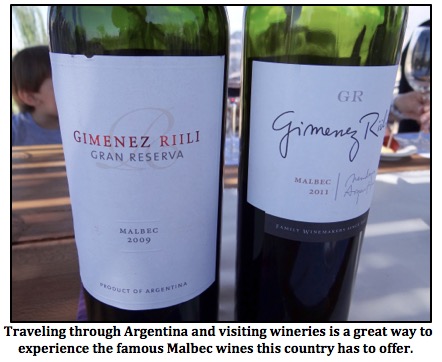
Certainly, consumers could travel great distances to participate in one of the trails highlighted, above, but with wine trails established in most U.S. states they need only travel a short distance from their home to have such an experience.
For the business, “by adding complimentary visitor-oriented services, wine businesses build brand loyalty, improve customer awareness and knowledge, create a positive image of the wine product and develop strong consumer relationships through planned on-site experiences” (http://bit.ly/2cmUu8a).
This blog will discuss the value of wine trails and present some of our research findings that describe participation and interest in wine trails and wine clubs.
What Benefits do Consumers and Tasting Rooms Enjoy when they Participate in a Wine Trail?
The Pennsylvania Winery Association describes some of the benefits consumers may experience if they participate in a wine trail versus just visiting an individual winery:
- A broader, more diverse wine experience,
- being able to spend time at multiple wineries throughout the day,
- the ability to compare and contrast wines sampled at each location, and
- learning about different techniques and styles each winemaker uses (http://www.pennsylvaniawine.com/traveling-a-wine-trail).
For the winery, the benefits of being part of a wine trail vary. Based on responses to a survey conducted by Fraser and Alonso, a majority of the 79 New Zealand winery trail participants did so:
- as “a means to selling more wine” (95%),
- because of “economic benefits” (81%),
- meet an “imperative business need” (32.9%), and
- “means of diversifying business” (17.7%) (http://bit.ly/2czq2X0).
Are Mid-Atlantic Wine Consumers Familiar with and Participating in Wine Trails?
Our March 2016 internet survey participants, all of whom drank and purchased wine at least once the previous year, were given a general definition of the term “wine trail” and asked if they were familiar with the term, if they had ever participated in a wine trail, and, if they had not, their interest in doing so in the future.
While an equal percent of super core (those who consumed wine daily to a few times a week) and core (consumed wine about once a week) wine consumers were familiar with the term “wine trail” (59.4 and 54.8%, respectively), fewer marginal wine drinkers (consumed wine less frequently) were familiar with the term (41.7%) (Figure 1).
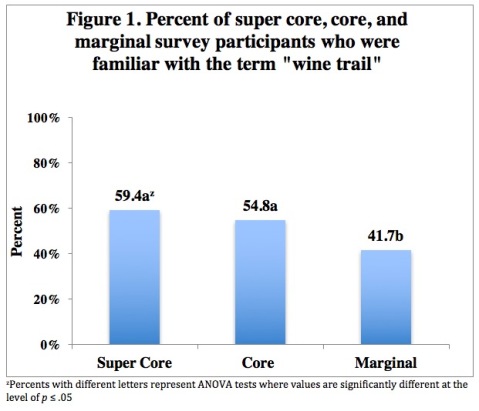 Participants were then asked if they had ever followed/participated in a wine trail. As might be expected, more super core participants (36.1%) responded that they had followed/participated in a wine trail compared to core (26.9%) and marginal (15.0%) wine consumers (Figure 2).
Participants were then asked if they had ever followed/participated in a wine trail. As might be expected, more super core participants (36.1%) responded that they had followed/participated in a wine trail compared to core (26.9%) and marginal (15.0%) wine consumers (Figure 2).
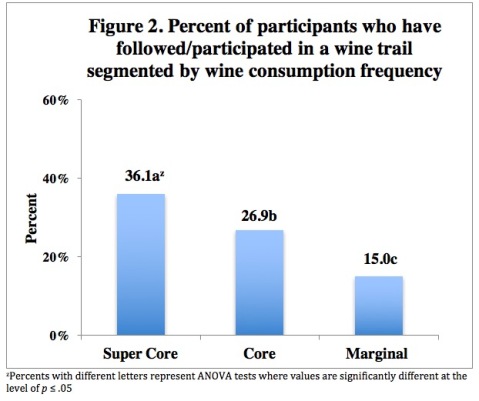
Those who had not followed/participated in a wine trail were then directed to a question that asked them to indicate their interest in doing so in the future. More than half of these participants were interested in doing so, regardless of wine consumption frequency: 70.5% of super core (Figure 3), 73.5% of core, and 63.3% of marginal.
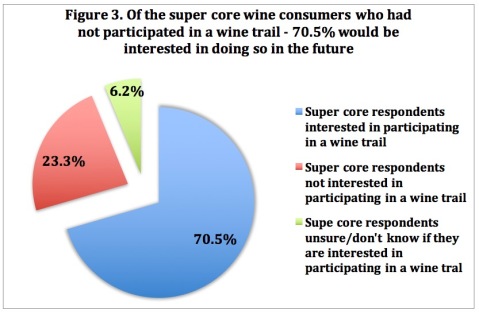
Might Wine Trail Promotional Programs Encourage Wine Consumers to Visit Multiple Tasting Rooms?
There are several strategies that can be implemented to encourage consumers to travel to a wine region, one of which is developing a program that includes incentives for visiting multiple tasting rooms. Some examples include:
- Wine Trail Passport: holders have access to free wine tastings, discounts on bottles of wine, and other benefits that are offered by participating winery tasting rooms for a certain period of time.
- Wine Trail Event Pass: event pass holders will not need to pay admission at any event offered by participating winery tasting rooms for a certain period of time.
- Wine Trail Ticket: ticket holders will receive a “giveaway” (for example, a wine glass, free additional wine sample, cloth tote) and those who visit all winery tasting rooms are entered into a drawing to win prizes.
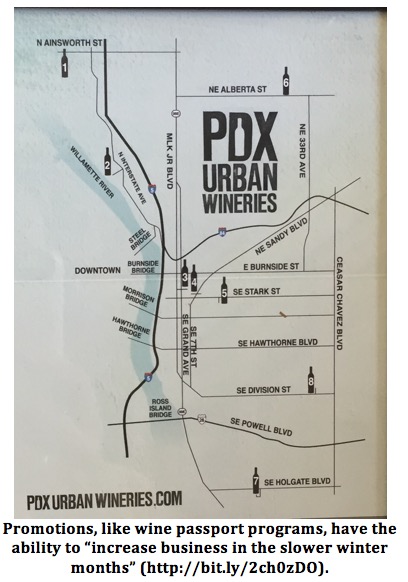
An article published by the MidWest Wine Press described the success of wine passport programs for Niagara-on-the-Lake Ontario wineries. According to Patty Aubry, Coyote’s Run Estate Winery, “Consumers don’t come to just one winery, they come to visit groups of wineries… these promotions give them a reason to visit the wine trail and also makes the winery selection process easier.” Ms. Aubry also mentioned that “the tasting pass program has proven to increase business in the slower winter months” (http://bit.ly/2ch0zDO).
In our survey, participants were asked to indicate their level of interest (not at all interested to extremely interested) in participating in each of the three programs, listed above, that a wine trail could offer (Table 1). Participants were told that the fee to participate would be the same for each option.
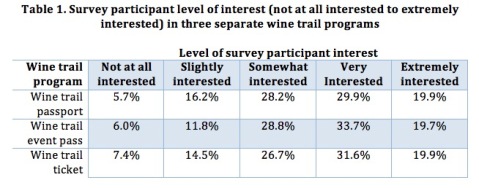
As shown in Table 1, approximately a third of all participants were “very interested” in each of the three programs, and an additional 19% were “extremely interested.” With our data showing that no one program was more appealing than the others, tasting room and trail organizers, who are exploring whether a particular program will entice their customers, should evaluate their participants’ reaction and interest in the three different programs.
Wine clubs
Wine clubs have evolved over the years and now serve as a way to attract wine drinkers by offering diverse programs that offer a fair amount of flexibility in order to cater to many tastes. Wine clubs can serve as the winery’s “loyalty programs” and increase customer loyalty and business profitability. Benefits of implementing a wine club can include:
- increased customer spending,
- higher profit margins,
- engaging customers for an extended amount of time, and
- improve client retention (http://bit.ly/2cQGULv).
Our survey participants were asked to indicate if they subscribed to or were a member of a wine club where they received wine and possibly other benefits on a scheduled basis (Figure 4). As you can see, the majority of participants were not wine club members or subscribers (12.4%); however, of the members/subscribers, a majority were of super core wine consumers (77.4%).
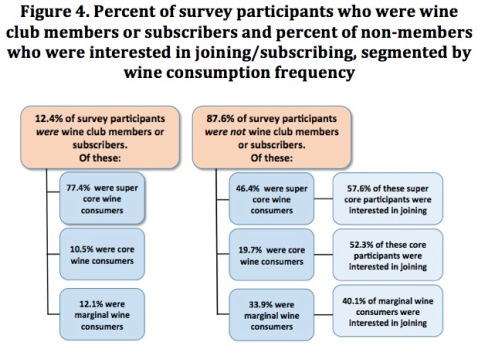
As seen above, while 87.6% of survey participants were not currently members or subscribers, between 40 and 60% of these participants were interested in joining a wine club. Based on these data, winery tasting rooms should explore this opportunity as it could be a way to encourage frequent visits and purchases.
Since wine club benefits, and how participants earn incentives, vary greatly, it is up to each tasting room to learn what potential and current members may value. You can learn more about various wine clubs by reading past Wine & Grape U. posts: http://bit.ly/1bGYLjy and http://bit.ly/2cUklpw.
Participants were also asked to indicate their level of interest (not at all interested to extremely interested) in joining a wine club by evaluating 12 variations of the following benefits:
- shipments of wine (frequency and number of bottles shipped at one time),
- discounts, and
- other benefits such as event invitations and access to specialty wines.
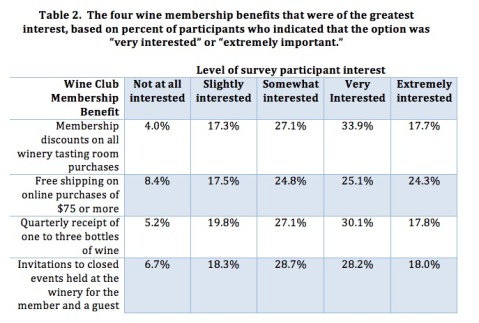
As you can see in the table, above, the wine club membership benefit that received the highest percent of “very interested” or “extremely interested” responses was “membership discounts on all winery tasting room purchases.” Pertaining to frequency of shipments, “quarterly receipt of one to three bottles of wine” was also rated higher than others tested: one to three bottles shipped monthly, more than three or more bottles shipped each month, and more than three bottles shipped each quarter.
Less favorable options, in terms of percent of participants who rated them “very interested” and “extremely interested” were:
- a subscription to a regional and/or wine newsletter or wine journal (included in the membership fee), 21.4% of participants were “very interested” 13.2% were “extremely interested,” and
- monthly receipt of more than three bottles of wine (either shipped to your home or picked up at the winery; no fee charged other than price of wine), 21.4% of participants were “very interested” and 14.3% were “extremely interested.”
Being a Wine Trail Member and offering a Wine Club – Final Thoughts
Winery tasting room owners and operators should constantly be looking at new programs, products, and offerings to encourage tasting room visits. Being a tasting trail participant or offering a wine club are two options to consider. Our data shows that over half of the super core and core wine participants were familiar with the term “wine trail.” Although 62.9% of super core consumers had not participated in a wine trail, 70.5% of these “non-participants” were interested in doing so in the future.
As a winery, participating in a wine trail is a way to drive business and increase customers. According to an Iowa study, “wine trails drive about 25 percent of the business to the wine shops, and wine trail visitors are desired customers as they tend to travel in groups and make larger purchases,” which has encourage more and more wineries to want to become members of wine trails in the state (Grybovych et al., 2013).
Pertaining to wine trail programs, about half of all participants were “very interested” and “extremely interested” in the three wine trail programs listed: wine trail passports, wine trail event passes, and wine trail tickets. Again, with our data showing that no one program was more appealing than the others, it would be advisable for tasting rooms/trails to evaluate visitors’ reaction and interest in these options.
Wine clubs are another option that could increase customer spending and customer loyalty. When designing a wine club program, consider options that were of greater interest to our survey respondents (e.g. member discounts, free shipping on online purchases $75 or more) and then get feedback from your tasting room visitors as to their likelihood of joining your program.
Wine trails and wine clubs not only have the potential to encouraging wine tourist to visit more frequently and make more purchases, but they also allow tasting rooms to offer these visitors a variety of fun, relaxing, and memorable experiences.
References:
Grybovych, O., J. Lankford, and S. Lankford. 2013. Motivations of wine travelers in rural northeast Iowa. International Journal of Wine Business Research, 25(4):285-309. DOI 10.1108/IJWBR-07-2012-0023
Other Researchers & Jennifer Zelinskie’s Thesis Advisory Team:
- Jeffrey Hyde, Professor, Agricultural Economics, The Pennsylvania State University
- Denise Gardner, Extension Enologist, Department of Food Science, The Pennsylvania State University
- Brad Rickard, Assistant Professor, Charles H. Dyson School of Applied Economics and Management, Cornell University
- Ramu Govindasamy, Professor, Department of Agricultural, Food and Resource Economics, Rutgers University
- Karl Storchmann, Clinical Professor, Economics Department, New York University; Managing Editor, Journal of Wine Economics
- Michela Centinari, Assistant Professor of Viticulture, Departemnt of Plant Science, The Pennsylvania State University
The project “Developing Wine Marketing Strategies for the Mid-Atlantic Region” (GRANT 11091317) is being funded by a USDA Federal-State Marketing Improvement Program grant, whose goal is “to assist in exploring new market opportunities for U.S. food and agricultural products and to encourage research and innovation aimed at improving the efficiency and performance of the marketing system.” For more information about the program, visit http://www.ams.usda.gov.
Tags: consumers, tasting room, wine consumers, wine marketing, winery
